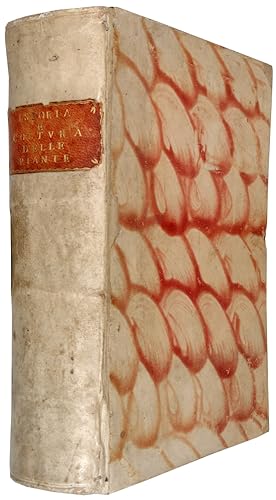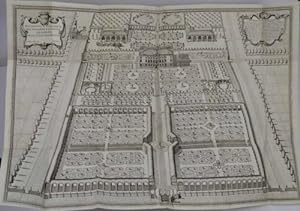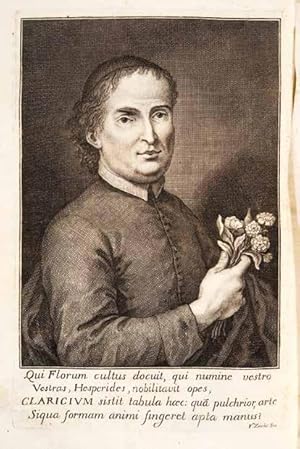Istoria e coltura delle piante (4 Ergebnisse)
Produktart
- Alle Produktarten
- Bücher (4)
- Magazine & Zeitschriften
- Comics
- Noten
- Kunst, Grafik & Poster
- Fotografien
- Karten
-
Manuskripte &
Papierantiquitäten
Zustand
- Alle
- Neu
- Antiquarisch/Gebraucht
Einband
Weitere Eigenschaften
- Erstausgabe (1)
- Signiert
- Schutzumschlag
- Angebotsfoto
Land des Verkäufers
Verkäuferbewertung
-
Istoria e coltura delle piante che sono pe'l fiore più ragguardevoli , e più distinte per ornare un giardino. con un copioso trattato degli agrumi.
Anbieter: Antiquariaat Junk, Amsterdam, Niederlande
Venezia, presso Andrea Poletti, 1726. 4to (235 x 175mm). pp. (34), 761, (3), with an engraved portrait of Clarici holding a bouquet of flowers in his right hand, an engraved title-vignette with a dwarf lemon tree in a pot with two putti, and a large engraved plan (530 x 740mm) of the Villa Marocco and its gardens. Contemporary half vellum, spine with red gilt lettered label, marbled sides. A fine copy of the first and only edition of one of the most important works on flower gardens and the cultivation of flowers of Northern Italy. Paolo Bartolomeo Clarici (1664-1725) 'spent most of his life in the Veneto where his literary and scientific tastes brought him the friendship of many members of the great Venetian families. Prominent among these was Gerardo Sagredo, Procurator of St Mark's, for whom he laid out a splendid garden in the Venetian style for the family villa at Marocco. Clarici used a print of a bird's eye view of this Marocco garden in his book as an ideal example of layout. predominantly a flower garden' (Masson, Italian gardens).'The work is divided into four sections: the first provides the reader with a brief history of the garden architecture and instructions on how to contruct a proper garden; the second is dedicated to cultivation techniques; the third to botanical history and the cultivation of certain prized flowering plants; and the fourth to a dissertation on citrus plants. 'Istoria e coltura della piante' was a work of serious scholarship, one based on careful reading of the most recent scientific works on botanical subjects as well as the author's own research. Thus Clarici left behind him a useful legacy that was to influence generations of garden architects and floriculturists both in Italy and elsewhere' (Tomasi, An Oak Spring Flora pp. 140-2).Pritzel 1728; Tomasi, An Oak Spring Flora No. 36.
-
Istoria e coltura delle piante che sono pe'l Fiore più ragguardevoli, e più distinte per ornare un Giardino in tutto il tempo dell'Anno, Con un copioso Trattato degli Agrumi&
Verlag: Presso Andrea Poletti,, In Venezia,, 1726
Anbieter: Studio Bibliografico Benacense, Riva del garda, Italien
Cm. 25, pp. (36) 761 + (3) d'errata. Con frontespizio in rosso e nero con vignetta centrale, ritratto dell'autore ed una grande tavola più volte ripiegata raffigurante: "Prospetto e topografia del Palazzo e Giardini Sagredo nella Villa di Marocco". Legatura strettamente coeva in cart. alla rustica con dorso ricoperto in origine con carta spugnata. Titoli a stampa su tassello (posteriore?). Una striscetta di carta rimossa al margine bianco inferiore del frontespizio per occultare una firma ms. di possesso, poche macchiette limitate alle cc. 527-529 ed una piccola mancanza al margine bianco di c. 723. Esemplare peraltro fresco e ben conservato. La grande tavola non presenta particolari difetti ed è stampata su carta forte. Celebre ed ampio trattato riguardante la coltura dei giardini redatto dal Clarici il quale fu tra l'altro incaricato da Gerardo Sagredo di sistemare in stile "veneto" il giardino della villa di famiglia a Marocco (Magliano Veneto). Di particolare interesse, oltre all'architettura dei giardini, l'attenzione del Clarici per l'aspetto botanico. Cfr. Filippo Re: "Abbiamo in Italia alcuni che scrissero diligentemente intorno alla coltivazione de' fiori; ma nessuno meglio, nè con maggior estensione e chiarezza lo fece del Clarici. Il Trattato sugli Agrumi, che forma la quarta parte, è opera unica nel suo genere". Curiosamente citato dal Gamba (2198) anche per meriti letterari.
-
Istoria e coltura delle piante che sono pe'l fiore più ragguardevoli, e più distinte per ornare un giardino in tutto il tempo dell'anno, con un copioso trattato degli agrumi. Opera postuma.
Verlag: In Venezia, presso Andrea Poletti, 1726
Anbieter: Gabriele Maspero Libri Antichi, Como, Italien
Zustand: Like New. In-4° (cm. 23,4), legatura coeva in piena pergamena rigida con titolo in oro su tassello; pp. [36] 761 [3] in ottimo stato, 1 tavola ripiegata più volte fuori testo incisa in rame da Francesco Zucchi (prospetto e topografia del palazzo e giardini Sagredo nella Villa di Marocco), 1 ritratto inciso in rame sempre dallo Zucchi a piena pagina nel testo (Clarici), frontespizio in rosso e nero con vignetta in rame (putti); sporadiche fioriture e lievissimi segni d'uso, iniziale al foglio di guardia. Celebre ed ampio trattato sulla coltura dei giardini, citato anche dal Gamba per meriti letterari. L'autore aveva sistemato per Gerardo Sagredo (qui dedicatario) il giardino della villa di famiglia a Marocco (Magliano Veneto), ben descritta in Mazzotti, Le Ville Venete, Treviso 1953, pp. 607-610. Questo libro è certamente importante, oltre che per l'architettura dei giardini, per la scienza botanica. Cfr. Pritzel 1728; Gamba 2198. Ottimo esemplare. (SD2).
-
Istoria e coltura delle piante che sono pe l fiore pi ragguardevoli, e pi distinte per ornare un giardino in tutto il tempo dell anno; con un copioso trattato degli agrumi. Opera postuma consacrata sua Eccelenza il Sig. Gerardo Sagredo.
Verlag: Venice, Andrea Poletti, 1726
Anbieter: Hünersdorff Rare Books ABA ILAB, London, Vereinigtes Königreich
Buch Erstausgabe
Soft cover. Zustand: Very Good. No Jacket. 1st Edition. 4to. [34] + 761 + [2] + [1 blank]p. Title in red and black. Engraved vignette on title-page signed FZ, portrait frontispiece of the author signed F. Zucchi; large engraved folding plan of the Villa Marocco and its garden (510 x 740mm) by Zucchi supplied in facsmile on old paper. Wood-engraved capitals, several large ornamental end-pieces (6 on otherwise blank pages). Original paste boards a la rustica . An important work for the documentation of flowers and the flower garden in the early 18th century. Clarici (1664-1725) was both scholar and practical horticulturist; his list of sources runs to 175 works, ranging from the classical authors to the most recent authorities, including botanists, pre-eminently, but also travellers, historians, architects, poets and writers on taste. Clarici s systematic work first provides an overall description of the garden and its site 10 miles from Venice. The book is then divided into four parts, the first covering the garden layout and responsibilities of the gardener; the second, the various skills required in cultivating plants in sections of the ornamental garden; the third, and major part (pp119- 152) subdivided into several chapters, describes individual plants (flowers, herbs, shrubs and spice trees) grouped according to their flower structure - there are numerous lists of contemporarily grown plants here with reference to their citation (if known) in earlier works. The fourth part is concerned with citrus fruits, and the cedar tree. The author's observations and notes are specially valuable in that he was up-to-date on the latest experiments in botanic and private gardens in Italy, and he knew well the day to day progress of the gardens round Padua where enthusiasm had been generated due to its famous botanic garden (founded in 1545) which continued to receive exotic plants from around the world for acclimatisation. Thus Clarici s work also provides a useful record of new species introduced; his perceptive knowledge additionally enabled him to clarify plants described by earlier authorities, such as Mattioli and Ferrari, with contemporarily listed ones, and establish the fact that many exotic species had existed in Europe long before they were assumed to have done so. It was through his contacts that Clarici had met his patron, Gerardo Sagrado, Procurator of St Mark s Cathedral, who had asked him to lay out his garden at Villa Marocco. The large engraved folding plan illustrates the layout, and is an example of Clarici s ideal. The book was posthunously published a year after its author s death by his nephew Domenico Clarici. A good copy, a few minor repairs. Pritzel 1728. Not in Hunt. See Georgina Masson, Italian Gardens, 1966, pp238-241, and Italian Flower Collectors Gardens in Seventeenth Century Italy in The Italian Garden (edited by David Coffin), Dumbarton Oaks, 1972, p64, where the above work is described as unexplored and invaluable for the wealth of information . about the flowers grown in Italy ; further that Clarici s book is remarkably scientific for the period, and his excellent bibliography a reminder of the fact that since the sixteenth century this world of flowers and gardens had been completely international . See also Lionel Puppi, The Villa Garden of the Veneto , in the same volume; and Claudia Lazzaro, The Italian Renaissance Garden, 1990.





